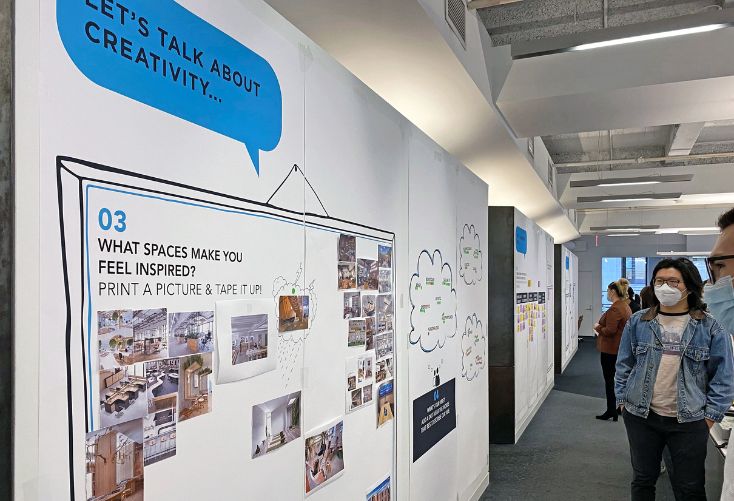- Organizations tend to take a virtual-first, function-first or culture-first approach to hybrid working.
- Visioning workshops and ecosystem mapping can help employers figure out their approach and refine it.
- Office space utilization can help make or break an organization’s bottom line and its ability to retain talent.
Hybrid working has become much more common for desk-based businesses, but how does a business owner know if their employees are happy with the arrangement? And how do they know if they’ve found the perfect balance between time spent working at home vs. working in the office?
Spectorgroup, a global architecture, interior design, and master planning firm uses visioning workshops and ecosystem mapping to determine how — and how often — employees work in the office. We caught up with Lauren Gardner, Director of Creative & Strategy and Steven South, Design Director & Senior Associate to discover more about the importance of setting intention for your hybrid work strategy.
Virtual, function or culture-first?
While Spectorgroup has been working with companies through the pandemic to rethink the way they utilize office space, three common categories have emerged: the virtual-first approach, the function-first approach, and the culture-first approach.
A virtual-first strategy is one that combines remote working with some in-person work. These teams work remotely most of the time (usually from home or a “third” space, such as a library or a coworking facility). The organization’s main office — or central “hub” — is used to facilitate collaborative work, training sessions, team building and social events.
According to Gardner and South, the function-first category is a hybrid planning approach driven by the work styles of the different departments within an organization.
“In this planning approach, department heads are empowered to decide how often their team needs to come into the office and the types of spaces required to support the tasks they’re performing on a daily basis,” Gardner and South explain.

While a function-first approach might work for some, other companies adopt a more culture-first mindset when it comes to workplace planning.
You could argue that culture-first is similar to virtual-first, but with a sharper focus on creating opportunities for collaboration. During the pandemic, people have learned that “individual tasks can be accomplished at home, and are now seeing the office as a place for connection, bringing employees together, and servicing clients.”
“Some departments will work fine fully remotely, while others will need more time in the office for team touchpoints during the week,” said Gardner and South.
Nothing is finite either; organizations will need to make adjustments as different needs arise.
“Some organizations come to us with an overall sense of what their policy will be moving forward, while others need us to do more of the data gathering first…sometimes an organization will have an idea at a high level, but once we start asking questions they realize they need to think deeper about a certain component,” Gardner and South added.
How do visioning workshops work?
Spectorgroup runs collaborative visioning workshops to discern whether a company is driven by virtual, function or culture, and to gain more insight into their business goals.
The insights gleaned from these sessions are then used to inform the company’s real estate planning. It is a qualitative experience, the desired outcome of which is to develop a shared vision based on multiple perspectives.
These workshops might focus on establishing what the future of work will look like for a specific company or aligning culture with an organizational shift.
“Interactive visioning workshops are part of a project’s process and use image associations to help determine the project’s aesthetic direction and what people like and dislike about various workplace categories,” Gardner and South explained.

Spectorgroup used visioning workshops, surveys and interviews to create a workplace strategy for the media group Stagwell, which comprises 18 different creative agencies.
The agencies were consolidating — literally — under one roof, and needed to work out how they could create an environment that would support each agency’s work styles, requirements, culture and brand, while simultaneously stitching them together. From a practical perspective, each agency needed to be able to grow or contract at short notice.
“Outcomes included flexible, standardized furniture solutions and smart planning that utilized large collaborative hubs to tie all the teams together.”
How does ecosystem mapping work?
Ecosystem mapping is useful for companies going through a big change, say Gardner and South. In fact, Spectorgroup used this strategy for its own new headquarters in Manhattan, when it decided to transition to a more activity-based office design approach.
Like visioning workshops, ecosystem mapping invites collective input. It prompts individuals to reflect on their behaviour in the workplace and encourages them to offer feedback and ideas. Crucially, the ecosystem mapping process allows individuals to contribute at their own pace.
Gardner and South explain: “Employees were asked to select images of spaces and purposefully arrange them on a blank canvas based on their desired flow and adjacencies. We did this both individually and as a group to determine the best ecosystem for our new office. We also put communal surveys up on the walls in public routes, and it was a great way to get employees engaged and feeling that they had a voice in the process. For employees who might be more reticent to provide feedback in a workshop, this gives them the opportunity to go up to the wall on their own time and provide feedback.”
After everyone has been given an opportunity to have their say, strategists can consider the similarities and differences between how different departments work, and blend approaches to formulate a workplace strategy that suits everyone.

The future of office utilization is smart
The normalization of hybrid working, coupled with the sense of uncertainty looming over the economy, is prompting organizations to focus on numbers: the number of people in the office and numbers on the balance sheet.
As Gardner and South point out, “now that we are taking a much more purposeful approach to planning we can allocate real estate more appropriately. One of the biggest outlying costs for a business is real estate. If you maximize real estate utilization, that really helps with the business’ bottom line.”


 Dr. Gleb Tsipursky – The Office Whisperer
Dr. Gleb Tsipursky – The Office Whisperer Nirit Cohen – WorkFutures
Nirit Cohen – WorkFutures Angela Howard – Culture Expert
Angela Howard – Culture Expert Drew Jones – Design & Innovation
Drew Jones – Design & Innovation Jonathan Price – CRE & Flex Expert
Jonathan Price – CRE & Flex Expert














